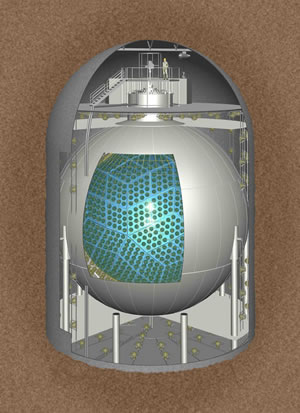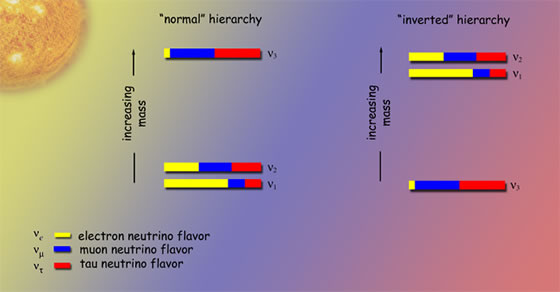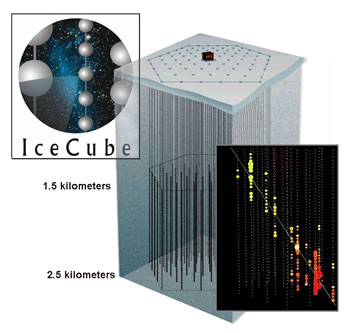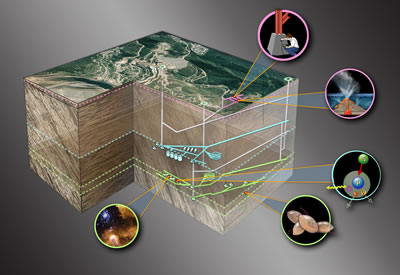The Surprising Neutrino
Concluding a two-part article on neutrino science at Berkeley Lab
By Paul Preuss
 Neutrinos have left-handed spin, while antineutrino spin is right-handed.
Neutrinos have left-handed spin, while antineutrino spin is right-handed.
The goal of the Sudbury Neutrino Observatory (SNO), built in the last decades of the 20th century, was to find the so-called missing solar neutrinos. Of the electron neutrinos created in the sun that ought to be detectable on Earth, only a third could be accounted for. What happened to the rest?
In 2001 SNO solved the problem, using a detector that could identify not only the sun’s electron neutrinos but also their cousins, muon and tau neutrinos. SNO demonstrated that neutrinos exchange identities on their way to Earth. What arrives is a spectrum of flavors.
It’s not just solar neutrinos that oscillate. All neutrinos do, including those produced when cosmic rays slam into Earth’s atmosphere, or those made when a proton beam from an accelerator hits a target. And so do the antineutrinos produced by radioactive decay in nuclear reactors.
What’s the difference between neutrinos and antineutrinos? Not much, it seems: neutrinos always spin left and antineutrinos always spin right. “Spin” isn’t Newtonian rotation, however, it’s a quantum number. In the case of neutrinos and other leptons, the spin number is one-half, which may sound non-common-sensical but is nevertheless deep – not to mention that it’s a useful way to tell otherwise indistinguishable particles apart.
Fusion reactions like those in the sun involve so-called beta-plus decays: a proton changes to a neutron plus a positron, the electron’s antiparticle, and an (ordinary) neutrino. To conserve angular momentum and balance the quantum variables – including those invoked by the weak force, which governs neutrinos – ordinary neutrino spin has to be left-handed. Fission reactions like those in a nuclear power plant involve beta-minus decays: a proton changes (again mediated by the weak force) to a neutron plus an electron and an antineutrino – whose spin must be right-handed.
The possibility arises that left-handed neutrinos and right-handed antineutrinos with even a little mass are actually the same – or, to put it another way, that the neutrino is its own antiparticle. Of which more later.
Measuring oscillations
In 2002, KamLAND, the Kamioka Liquid-scintillator Antineutrino Detector, began measuring oscillation in reactor-produced antineutrinos. Buried in a mine in southern Japan and surrounded by dozens of commercial power reactors at distances averaging 180 kilometers, KamLAND is a steel tank lined with photomultiplier tubes and filled with liquid that fluoresces when it absorbs an energetic charged particle. A handful of the antineutrinos that enter the scintillator betray themselves by triggering two tell-tale flashes of light, the signal of an inverse beta decay.
 The KamLAND experiment in Japan measured the oscillation of antineutrinos produced in nuclear power reactors.
The KamLAND experiment in Japan measured the oscillation of antineutrinos produced in nuclear power reactors.
When an antineutrino whacks a proton, the proton spits out a positron and turns into a neutron. The positron, being antimatter, promptly annihilates with any nearby electron – the first flash of light. A few microseconds later the neutron fuses with a proton and emits a gamma ray – the second flash of light.
Stuart Freedman of the Nuclear Sciences Division headed a team from Berkeley Lab and UC Berkeley that built the front-end electronics for KamLAND’s photomultiplier tubes and helped analyze the data. KamLAND provided a direct measurement of neutrino oscillation by calculating how many electron antineutrinos “disappeared” (by changing flavors) on their way from the reactors to the detector.
Neutrino flavors must have different masses, else what’s to oscillate? But theorists realized early on that none of the neutrino flavors we can detect are pure; an electron-flavored neutrino is actually a mix of electron, muon, and tau-neutrino mass states, dominated by the electron neutrino’s mass.
The muon neutrino is a slightly heavier mixture of the three mass states, while the proportions in the tau-flavored neutrino are unknown – so uncertain we’re unsure whether the tau flavor is the heaviest or lightest. The missing piece of the puzzle is the “mixing angle” that controls how much of the tau flavor consists of the electron-neutrino mass state. Labeled Θ13 (pronounced theta one three), this elusive mixing angle (two others are better known) is the key to eventually finding the masses of all the neutrino flavors.
 Detectors don’t see pure flavors, only mixtures of mass states. Differences among the mixed states have been measured but the masses are unknown. Also unknown is whether the biggest difference marks the heaviest mixed state or the lightest one.
Detectors don’t see pure flavors, only mixtures of mass states. Differences among the mixed states have been measured but the masses are unknown. Also unknown is whether the biggest difference marks the heaviest mixed state or the lightest one.
The search for theta one three: Θ13
An ambitious effort to find Θ13 makes use of the flood of antineutrinos produced by powerful reactors at Daya Bay on China’s coast northeast of Hong Kong. The Daya Bay Experiment brings together scientists from 20-plus institutions in Asia, the U.S., and Europe. Kam-Biu Luk of UC Berkeley and Berkeley Lab’s Physics Division is one of the experiment’s two scientific spokespersons, and Bill Edwards of the Physics Division is the U.S. Project Manager overseeing construction.
Tunnels totaling three kilometers in length are now being drilled under the granite mountains adjacent to the reactors. In chambers shielded from cosmic rays by the overlying rock the researchers will install eight mobile detectors filled with fluid scintillator, each weighing 100 metric tons, some positioned close to the reactors and some far away.
“We are midway through the process of getting our experiment built,” says Edwards. Parts of the detectors and their transport system are now undergoing testing, “more than a kilometer of tunnel has been dug, and excavation of the first experimental hall is well underway.”
Says Luk, “We plan to start data-taking with two antineutrino detectors in the Daya Bay Near Hall in the first half of 2010; data-taking with all eight in the three underground halls will begin by June 2011. To get theta one three, essentially we’ll measure the difference in antineutrino flux at two points. Basically it comes down to how many antineutrinos disappear.”
Neutrinos from stars like the sun and from nuclear reactors have relatively low energies (measured in millions of electron volts or less), but the universe bristles with neutrinos whose energies may reach trillions to quadrillions of electron volts. Many of these are created when super-energetic cosmic rays, particles accelerated by mechanisms yet unknown, collide with the ubiquitous photons of the cosmic microwave background.
To find the sources of these powerful cosmic rays, researchers plan to sight back along the tracks of the energetic neutrinos they create. Undeflected by electromagnetism, hardly touched by gravity, neutrinos fly through intervening matter – gas, dust, the occasional star – unperturbed, and will open a new window on mysterious phenomena like blazars, gamma ray bursts, and the star-eating black holes that power active galactic nuclei.
Neutrinos on ice
The trade-off is that a neutrino telescope has to be very, very big to capture any useful data. The multinational IceCube collaboration uses a cubic kilometer of remarkably transparent ice beneath the South Pole to map neutrinos of all flavors, tracking the faint blue light called Cherenkov radiation that’s emitted when charged particles like muons – products of neutrino collisions with atoms – move faster than the speed of light ... in ice. (Nothing travels faster than light in a vacuum.)
 IceCube is a telescope in the South Polar ice where thousands of photomultiplier tubes capture the tracks of muons created as energetic neutrinos pass through Earth.
IceCube is a telescope in the South Polar ice where thousands of photomultiplier tubes capture the tracks of muons created as energetic neutrinos pass through Earth.
IceCube was designed to suspend 80 vertical cables in shafts reaching 2.5 kilometers down into the ice, carrying a total of 4,800 photomultiplier tubes. Packaged in glass spheres, the photomultipliers and their electronics, called Digital Optical Modules, or DOMs, were designed, engineered, and prototyped at Berkeley Lab. The process of drilling shafts with hot water, lowering strings of DOMs into them, and freezing them into place has gone more smoothly with each drilling season.
“After five seasons we’re up to 59 strings, and 98 percent of the DOMs have survived freeze-in; the electronics work,” says Spencer Klein of the Nuclear Sciences Division, Berkeley Lab’s IceCube group leader. “As a result, we have added six new strings, called DeepCore, which create a region of densely spaced DOMs in the center of IceCube. This high-density core will greatly increase IceCube’s sensitivity to lower-energy neutrinos and should reduce IceCube’s energy threshold by an order of magnitude.”
Cosmic rays striking the atmosphere over the South Pole pepper the ice with downward-traveling muons; consequently IceCube has concentrated on muons coming up from below, made by neutrinos that have come all the way through Earth and left any fellow travelers behind. With data from the first 22 strings, IceCube mapped some 5,000 energetic neutrino events in the northern sky, probably the result of “air showers” caused by cosmic rays in the northern atmosphere. But when all 86 strings of DOMs are in place, the telescope has an excellent chance of identifying steady point-sources of high-energy neutrinos far off in the universe, allowing peeks at otherwise invisible phenomena like the hearts of active galactic nuclei.
Deep science
One of the most famous places in the history of neutrino science is the Homestake Mine in South Dakota, where experimenter Ray Davis and theorist John Bahcall first posed the missing solar neutrino puzzle that SNO solved almost 40 years later. Kevin Lesko of the Nuclear Sciences Division led Berkeley Lab’s participation in SNO and now heads up a Berkeley Lab-UC Berkeley team, supported by the National Science Foundation, to design DUSEL, a Deep Underground Science and Engineering Laboratory, at Homestake.
 The Deep Underground Science and Engineering Laboratory will house experiments in astrophysics, biology, geoscience, and engineering, from the surface to 2.25 kilometers below.
The Deep Underground Science and Engineering Laboratory will house experiments in astrophysics, biology, geoscience, and engineering, from the surface to 2.25 kilometers below.
Scientific users from many institutions will use DUSEL to tackle exciting fields including “Dark Life” (microbiology), geoscience, and engineering. But the predominant impetus is physics, and neutrinos are a big part of the physics.
At the 4,850-foot level – named the Davis Level after Ray Davis’s pioneering neutrino experiment – vast caverns each filled with a million tons of pure water will capture neutrinos of all flavors, originating not in the sun or nuclear reactors but from accelerators at the Fermi National Accelerator Laboratory in Illinois, 1,300 kilometers away, or the Brookhaven National Laboratory on Long Island, 2,500 kilometers away.
Accelerators make neutrinos by smashing protons into targets. Moving the target, filtering the products, and other adjustments can favor the production of different neutrino flavors. While neutrinos can’t be focused – unlike light, they are unresponsive to electric or magnetic fields – accelerator-produced neutrinos do keep moving in roughly the same direction as the particles that created them; this neutrino “beam” can be aimed, more or less directly, at a distant detector like the buried caverns of DUSEL – even straight through the earth, ignoring Earth’s curvature.
“We can observe the appearance and the disappearance of different neutrino species by using these long-baseline accelerator neutrinos,” says Lesko. “Investigating that metamorphosis will help physicists understand if neutrinos obey conservation laws, which may shed light on the behavior of matter and antimatter. The ultimate goal is to explain why our universe is dominated by matter.”
Why do we exist?
Another experiment planned for DUSEL attacks the antimatter question directly. “In physics, everything not forbidden is compulsory,” theorist Murray Gell-Mann famously decreed. A nuclear reaction called neutrinoless double beta decay has never been observed, but is it forbidden? If not, then it must occur, settling the question of whether the neutrino is its own antiparticle.
In heavy nuclei, occasionally two neutrons change into protons (or two protons change into neutrons) at the same time, releasing two antineutrinos (or two neutrinos). If such a double beta decay occurred without producing either, it would suggest that the neutrinos annihilated each other – that indeed they are each other’s antiparticles, so-called Majorana neutrinos.
Hitoshi Murayama, UC Berkeley and Berkeley Lab theorist and head of the University of Tokyo’s Institute for the Physics and Mathematics of the Universe, puts it this way: if there is no distinction between neutrinos and antineutrinos – which are particles of matter (unlike photons, also their own antiparticles) – then matter and antimatter can change into each other.
“The equal amounts of matter and antimatter created in the big bang mutually annihilated as the universe cooled, but roughly one in every 10 billion particles of matter survived and went on to create stars, galaxies, and life on Earth,” says Murayama. How could this happen? Heavy Majorana neutrinos produced in the first instant of the big bang eventually would have decayed into lighter left-handed neutrinos and right-handed antineutrinos. The slightest difference in the probability of one path versus the other would lead to the imbalance of one type – we call it matter – over the other, which makes existence possible.
Berkeley Lab’s Freedman is currently leading the U.S. participation in a search for neutrinoless beta decay at the Gran Sasso Laboratory in Italy, called the CUORE experiment. If neutrinoless beta decays are not found in Italy, a larger, deeper detector such as the one planned for the deepest underground laboratory in the world, in DUSEL, may be needed to do the job.
Ignorance about the missing energy in beta decays first brought the neutrino to our attention. Tracking down its mysteries may yet teach us why we are even here to ask these questions. The answers are sure to open new vistas of fruitful ignorance.
Additional information
- To read Part I of this article, go here, or click on the link at upper left
- For more about Berkeley Lab’s participation in KamLAND, visit http://kamland.lbl.gov/
- KamLAND was also the first experiment to detect geoneutrinos, antineutrinos produced by nuclear decays deep in Earth’s mantle. Visit http://www.lbl.gov/Science-Articles/Archive/NSD-KamLAND-geoneutrinos.html
- For more about the participation of Berkeley Lab and UC Berkeley in the Daya Bay experiment, visit http://neutrino.physics.berkeley.edu/index.html
- For more about the search for Θ13, theta one three, visit http://www.lbl.gov/Science-Articles/Archive/sabl/2006/Jul/03.html
- The Daya Bay experiment’s main site is at http://dayawane.ihep.ac.cn/twiki/bin/view/Public/
- For more about Berkeley Lab’s participation in IceCube, visit http://icecube.lbl.gov/
- For more about DUSEL, visit http://www.lbl.gov/nsd/homestake/
- Everything you ever wanted to know about making neutrino beams with a particle accelerator is here.
- For more about the search for neutrinoless beta decay and the U.S. participation in CUORE, visit http://cuore.lbl.gov/index.html
- To learn why neutrinos may hold the key to our existence, visit Hitoshi Murayama’s website at http://hitoshi.berkeley.edu/neutrino/neutrino5.html


